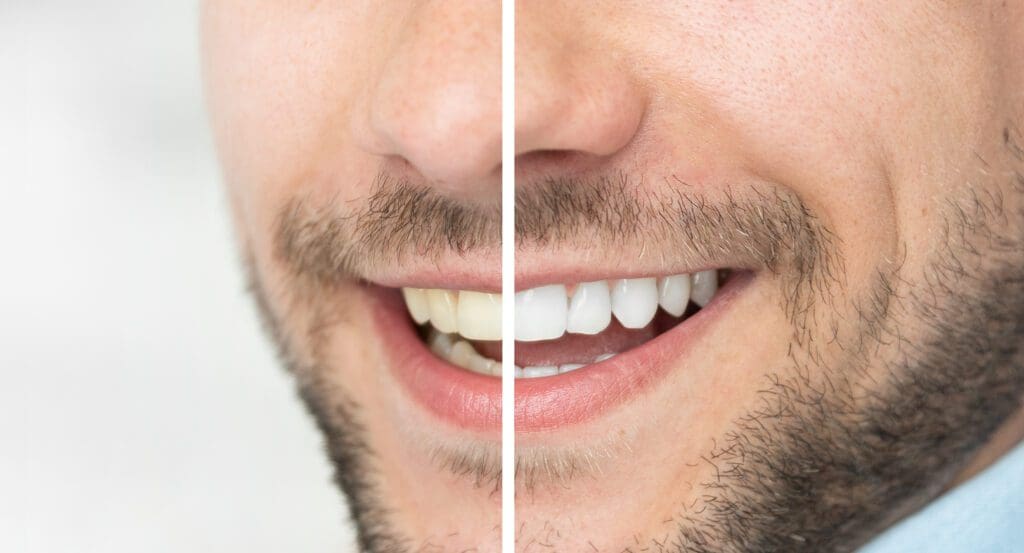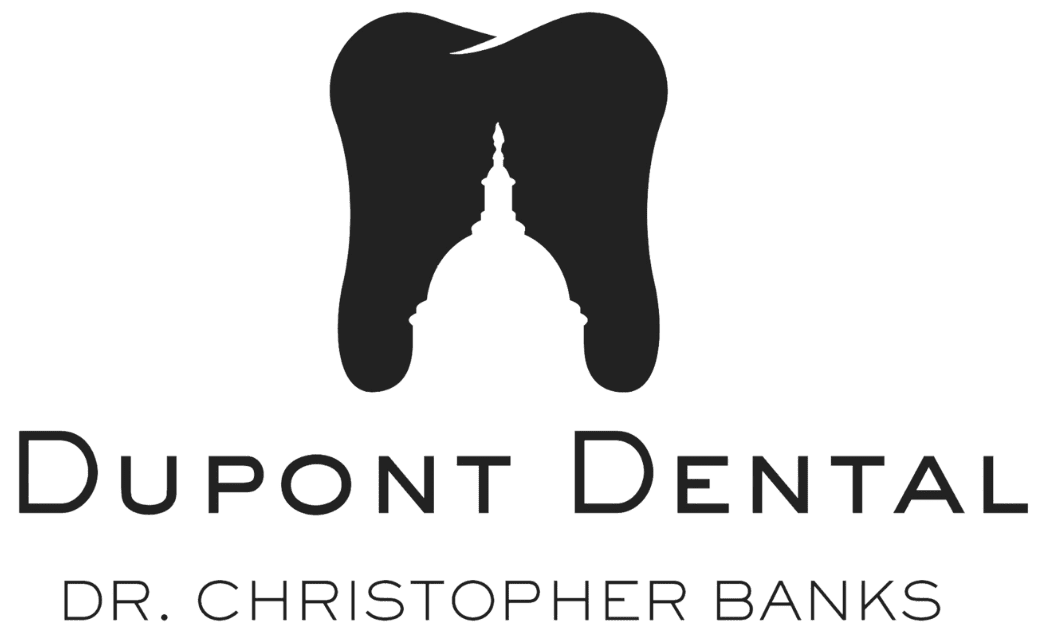Have you tried over-the-counter teeth whitening treatments with minimal results? You can erase years of stains and yellowing with one of our premier whitening treatments. We offer in-office and take-home options using professional Zoom and Opalescence™ teeth whitening in our Washington, DC, office.
At Dupont Dental, we work with patients to find the correct teeth whitening treatment for their needs. We consider your tooth sensitivity and the cause of your discoloration. Teeth whitening is a cosmetic dental treatment that can lift tooth stains and create brighter smiles.

What Causes Tooth Discoloration?
Your teeth can stain for many reasons. The most common causes of discolored and yellowed teeth include:
- Foods and Drinks: Berries, coffee, wine, tea, tomatoes, and other foods and beverages can dye the tooth enamel. Coffee and tea are rich in tannins, which can also contribute to staining. Red wine contains both chromogens and tannins. Foods like tomatoes have natural acids and pigments that can impact the color of your teeth.
- Tobacco Products: The nicotine found in tobacco products can seep into the enamel, or the outer layer of your teeth. It can cause your teeth to develop a brownish or yellowish tint over time. The tar in cigarettes can also add to these stains, making them more noticeable. While vape pens might not contain tar, they still have nicotine and other chemicals that stain.
- Medications: Antihistamines, antipsychotics, and other medications can have tooth discoloration as a side effect. Some drugs might lead to staining or a change in the tooth’s surface. Others may reduce the flow of saliva, which helps keep your teeth clean and can lead to discoloration.
- Injuries: Tooth wear, fractures, or chips and cracks in the teeth can affect the pulp within the tooth and create a discolored look. Injuries to the outer tooth layer, or enamel, expose dentin, the underlayer. Dentin is a darker shade than your enamel and can make your teeth appear darker.
What are the Types of Tooth Stains?
Tooth stains can be intrinsic or extrinsic. Intrinsic stains develop inside the tooth. They can happen when the inner structure of the tooth, called dentin, darkens or becomes discolored. This type of stain is often caused by certain medications, injuries, too much fluoride, or aging. Because intrinsic stains are beneath the surface, they usually don’t respond well to regular whitening toothpaste and may require professional treatment.
Extrinsic stains form on the outer surface of the teeth. These stains are usually caused by everyday habits like drinking coffee, tea, or red wine, or by using tobacco products. Extrinsic stains are more common and can often be removed with professional dental cleanings or teeth whitening treatments.
Dr. Banks will examine your mouth and review your medical history and medications to find the best treatment for your type of staining.
Teeth Whitening Treatment at Dupont Dental
We offer two different types of teeth whitening treatments in our Washington, DC, dentist office for patients who want in-office or take-home care. Dr. Banks will review both options and determine if you’re a good candidate for teeth whitening. He may recommend treating concerns like gum disease or cavities first.
Zoom Teeth Whitening
Our Zoom in-office whitening system can brighten your smile by six to eight shades within one hour. When you visit our office for Zoom treatment, we’ll isolate the teeth and cover the gums to minimize sensitivity. Then, we apply the gel evenly to each tooth.
We use light to activate the ingredients in the whitening gel, allowing hydrogen peroxide and other active ingredients to penetrate the teeth. After about fifteen minutes, we remove the gel and repeat the process. We can repeat this process twice until you receive your desired results. Zoom whitening is an excellent option for patients attending special events because it delivers quick results.
Opalescence Teeth Whitening
The Opalescence teeth whitening system offers a convenient way for patients to whiten their smiles at home. During a visit to our office, we will take dental impressions to ensure that the tray conforms to your teeth. Then, we will fit you with a comfortable and custom-made whitening tray and provide whitening gel.
At home, you will evenly fill the tray with the gel and wear the tray while you sleep. Opalescence delivers the choice of five different concentrations of active ingredients for the whitening gel. This treatment is great for patients with tooth sensitivity.
Alternatives to Teeth Whitening
We offer cosmetic options to whiten teeth if you have deep tooth stains or discolored teeth resulting from dental injuries. Materials like porcelain or composite resin can improve the color and shape of your teeth. Dental veneers are a great choice if you have stubborn stains or if you want to correct uneven or chipped teeth.
Dental bonding involves applying a tooth-colored resin to your teeth to improve their appearance. We shape and polish the resin to match the natural look of your teeth. Bonding can fix minor imperfections. It also offers a quicker and less expensive option compared to veneers.
How to Keep Teeth White
You want to maintain your results after treatment. The right care can help your bright teeth last. After whitening treatment, you should follow these tips:
- Avoid Staining Foods and Drinks: Avoid foods and drinks that can stain your teeth, such as coffee, tea, red wine, and berries. If you do consume them, ensure you also drink water and clean your teeth afterward. Water will help rinse away any lingering pigments and acids from your mouth. Brushing your teeth removes residue and prevents the pigments from settling into your enamel.
- Practice Good Oral Hygiene: Brush your teeth twice daily with a whitening toothpaste to help remove stains and keep your teeth clean. Don’t forget to floss daily to remove plaque and food particles between your teeth. You can keep your teeth bright when you brush and floss twice a day.
- Use a Straw: We recommend that you drink staining drinks with a straw. Using a straw can reduce your chance of staining. When staining compounds have less contact with the surface of your teeth, it can reduce the risk of stains.
- Quit Smoking: Smoking can cause your teeth to become yellow and stain over time. Quitting smoking will not only help keep your teeth white but also improve your overall oral health. When you stop using tobacco products, you also help reduce your risk of oral cancer and gum disease.
- Regular Dental Check-ups: Visit our dentist regularly for cleanings and check-ups. Removing plaque and tartar from your teeth can help keep your teeth bright. At these visits, our dentist can also offer advice on how to maintain your whitening results.
You may also want to consider getting touch-up treatments. Dr. Banks can recommend how often you might need them to keep your teeth looking bright. The right schedule for you can make your results last.
Patient Review
Frequently Asked Questions
Do you want to know more? We’re here to help. We have answers to some of the most commonly asked questions about teeth whitening in Washington, DC.
How long after teeth whitening can I eat normally?
You can eat normally for about 24 to 48 hours after teeth whitening. During this time, avoid staining foods and drinks like coffee, tea, and red wine, as your teeth are more porous and prone to discoloration. After this period, you can resume your regular diet.
Should I get my teeth cleaned before whitening?
Yes, getting a teeth cleaning before whitening ensures better results. Cleanings remove plaque and tartar that can block the whitening agent from evenly penetrating your teeth. This step helps achieve more effective and uniform whitening.
Does teeth whitening remove plaque?
No, whitening your teeth won’t remove plaque. Whitening treatments focus on changing the color of your teeth by bleaching stains, but they don’t clean or remove plaque buildup. You need to brush, floss, and get professional dental cleanings to remove bacterial buildup. We’ll clean your teeth and gums before we whiten your teeth or the best results.
Will teeth whitening work on fillings?
Teeth whitening doesn’t work on fillings or other restorations like crowns or veneers. The whitening agents only affect natural tooth enamel. If fillings look discolored after whitening, you may need replacement to match your brighter teeth.
Can you use teeth whitening strips with Invisalign?
You shouldn’t use whitening strips while wearing Invisalign aligners. Strips won’t adhere properly, and the aligners can trap whitening gel, leading to uneven results. Instead, consult our dentist about whitening solutions designed for aligner users.
How many shades does in-office teeth whitening whiten?
In-office teeth whitening can lighten your teeth by 3 to 8 shades in a single session. The exact result depends on the starting color of your teeth and the type of stains. Professional whitening offers the most noticeable and immediate improvement.
How long does Zoom and Opalescence teeth whitening last?
The results from Zoom and Opalescence teeth whitening can last anywhere from six months to two years. How long your smile stays bright depends on your daily habits, such as what you eat and drink, and how well you take care of your teeth. Drinking coffee, tea, or red wine and using tobacco products can cause stains to return faster.
Can I whiten my teeth if I have gum disease or cavities?
No, it’s not safe to whiten your teeth if you have gum disease or untreated cavities. Whitening gels can make these problems worse and may cause pain or irritation. For example, if you have a cavity, the whitening solution can reach the inside of the tooth and cause tooth sensitivity.
Dr. Banks will check your mouth before whitening to make sure your teeth and gums are healthy. You need to treat gum disease or cavities first.
Schedule a Whitening Consultation
Do you have dull or discolored teeth? Get brighter teeth with in-office or take-home teeth whitening treatment in Washington, DC. Call Dupont Dental today at (202) 946-4720.
You can also schedule a dental appointment with Dr. Banks online. Please let Dr. Banks know if you have questions or concerns. He’s here to help.
